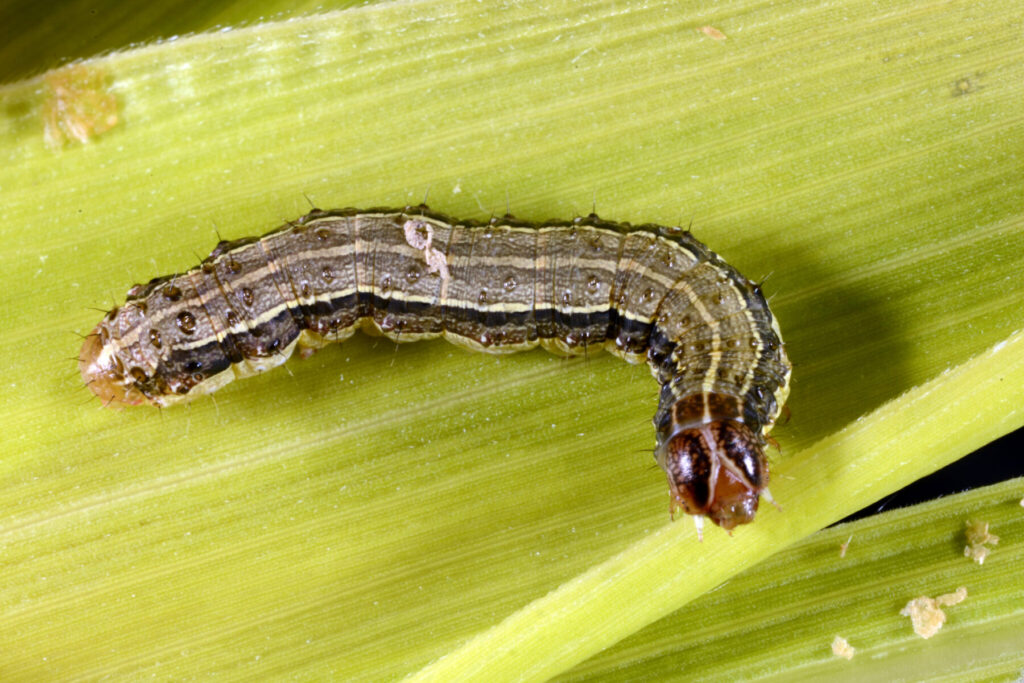By: Shanna Reynolds

Don’t let their name fool you, as the dreadful “fall” armyworms have graced our presence in Georgia as early as June for two years in a row. They haven’t made it to our fields in northern Georgia as I write this article, but three confirmed cases by our agents in southern counties tell me it’s only a matter of time. It’s not a question of IF we will have problems with fall armyworms (FAW) this year, but WHEN and HOW BAD.
Last year, armyworms devastated pastures and hay crops throughout our state from June until October. Our local feed stores had a hard time keeping enough chemicals on the shelves to treat fields, and farmers without a pesticide applicator license felt the urgency to get approved. I’m told by veteran agents it wasn’t the worst we’ve ever dealt with, but it may have been close. There were so many armyworms at my office that they ran out of places to go, and we had to sweep them off our entryway a couple of mornings.
If FAW hit you hard last year, I probably have your attention right now. Let’s talk through some suggestions for how to stay ahead of these pests before they hit your area or get any worse. The FAW (actually a caterpillar, not a worm) can quickly decimate a field of forage; they prefer fields with our highest quality nutrition, and they will remove nearly all tender green vegetation. Injury to a field may first appear as drought damage, such as thinned grass and brown spots. As worm populations build, the only thing left may be the tough plant stems. Scouting often and taking timely action will help you maintain the most usable crop.
Young worms tend to stay down deep in the shade of the grass canopy during the day and are hard to see. Larger worms are easier to find, but they may be too mature to manage with pesticides. Scout early in the morning and late in the afternoon when temperatures are cooler. The worms are most active at this time and are easier to spot. Sweep nets are a very helpful tool in finding the younger worms. Many farmers keep an eye out for birds in the field, which is a good sign that FAW are present, but I would not rely on the presence of birds alone. One of the most distinct characteristics of an adult FAW is the inverted Y-shape on its head. But bring in a caterpillar or pictures to your local Extension office if you need help with identification. Treatment is recommended when there are, on average, 3 or more worms per square foot found in a field.
So what if I find FAW? UGA Extension’s recommendations vary based on the size of the worms, the density of infestation, and the stage of forage growth. You have more options if worms are found small (under ¾ inch long). If the forage is tall enough to harvest, do so. If the field has been cut or grazed recently and there is less than 6 inches of forage growth, we recommend using an approved insecticide. If the forage is 6-8 inches tall, allow livestock to graze it or use a mower to clip it down before spraying with an insecticide. If the worms found are longer than ¾ inch, insecticides aren’t effective. Graze or cut the forage for hay as soon as possible. If there isn’t enough forage height to cut for hay, mow before applying an approved insecticide.

There are a few factors to consider when choosing an insecticide to manage armyworms. Last year, the biggest deciding factor in my area was which product was available for purchase. Assuming you
have multiple products to choose from, consider the cost per acre and residual potential of each chemical. Also, study any grazing or harvest restrictions for a chemical. For example, Cyfluthrin (commonly sold under the trade name “Tombstone”) is a popular option that is fairly inexpensive while having no grazing or haying restriction. This might be a good option for a pasture that is 8-10 inches tall, and you have the ability to go ahead and let your cattle graze that forage down soon. For a hayfield that was baled two weeks ago, something like Diflubenzuron (Trade name “Dimlin”) may be a better option if worms are discovered young because it offers some residual protection to get you through until your next intended harvest. With numerous chemical options available, feel free to contact your local agent for help deciding which is best for your situation.
